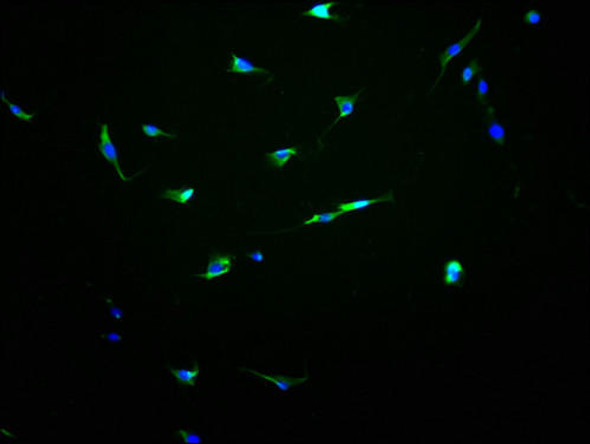Description
| Antibody Name: | STAP1 Antibody (PACO42342) |
| Antibody SKU: | PACO42342 |
| Size: | 50ug |
| Host Species: | Rabbit |
| Tested Applications: | ELISA |
| Recommended Dilutions: | |
| Species Reactivity: | Human |
| Immunogen: | Recombinant Human Signal-transducing adaptor protein 1 protein (1-295AA) |
| Form: | Liquid |
| Storage Buffer: | Preservative: 0.03% Proclin 300 Constituents: 50% Glycerol, 0.01M PBS, PH 7.4 |
| Purification Method: | >95%, Protein G purified |
| Clonality: | Polyclonal |
| Isotype: | IgG |
| Conjugate: | Non-conjugated |
| Background: | In BCR signaling, appears to function as a docking protein acting downstream of TEC and participates in a positive feedback loop by increasing the activity of TEC. |
| Synonyms: | Signal-transducing adaptor protein 1 (STAP-1) (BCR downstream-signaling protein 1) (Docking protein BRDG1) (Stem cell adaptor protein 1), STAP1, BRDG1 |
| UniProt Protein Function: | STAP1: an adaptor protein which contains pleckstrin homology (PH) and Src homology 2-like (SRC) domains and a proline-rich region. Induced in activated bone marrow-derived macrophages, and by CpG, LPS, and interferon in myeloid cell lines. Induces pro-inflammatory responses and may contribute to neuronal apoptosis and degeneration. Overexpressed, it interacts with the CSFR, inhibiting its ligand-dependent phosphorylation. Its expression inhibits cellular migration and can increase cytotoxicity against 661W photoreceptor like cells.Protein type: Adaptor/scaffoldChromosomal Location of Human Ortholog: 4q13.2Cellular Component: cytoplasm; mitochondrion; nucleus; protein complexMolecular Function: phosphotyrosine binding; protein binding; protein kinase binding; SH3/SH2 adaptor activity; transmembrane receptor protein tyrosine kinase adaptor protein activityBiological Process: negative regulation of phosphorylation; positive regulation of B cell receptor signaling pathway; positive regulation of phagocytosis, engulfment; transmembrane receptor protein tyrosine kinase signaling pathway |
| UniProt Protein Details: | |
| NCBI Summary: | The protein encoded by this gene contains a proline-rich region, a pleckstrin homology (PH) domain, and a region in the carboxy terminal half with similarity to the Src Homology 2 (SH2) domain. This protein is a substrate of tyrosine-protein kinase Tec, and its interaction with tyrosine-protein kinase Tec is phosphorylation-dependent. This protein is thought to participate in a positive feedback loop by upregulating the activity of tyrosine-protein kinase Tec. Variants of this gene have been associated with autosomal-dominant hypercholesterolemia (ADH), which is characterized by elevated low-density lipoprotein cholesterol levels and in increased risk of coronary vascular disease. Alternative splicing results in multiple transcript variants. [provided by RefSeq, Dec 2015] |
| UniProt Code: | Q9ULZ2 |
| NCBI GenInfo Identifier: | 62511239 |
| NCBI Gene ID: | 26228 |
| NCBI Accession: | Q9ULZ2.1 |
| UniProt Secondary Accession: | Q9ULZ2,B2R980 |
| UniProt Related Accession: | Q9ULZ2 |
| Molecular Weight: | 34,291 Da |
| NCBI Full Name: | Signal-transducing adaptor protein 1 |
| NCBI Synonym Full Names: | signal transducing adaptor family member 1 |
| NCBI Official Symbol: | STAP1 |
| NCBI Official Synonym Symbols: | BRDG1; STAP-1 |
| NCBI Protein Information: | signal-transducing adaptor protein 1 |
| UniProt Protein Name: | Signal-transducing adaptor protein 1 |
| UniProt Synonym Protein Names: | BCR downstream-signaling protein 1; Docking protein BRDG1; Stem cell adaptor protein 1 |
| Protein Family: | Signal-transducing adaptor protein |
| UniProt Gene Name: | STAP1 |
| UniProt Entry Name: | STAP1_HUMAN |






